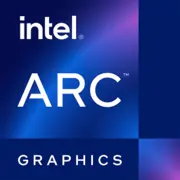Intel Arc A750

Intel Arc A750: Detailed Review of the 2025 Graphics Card
New Hope for Budget Gamers and Enthusiasts
1. Architecture and Key Features
Xe-HPG: The Heart of Intel Arc
The Intel Arc A750 graphics card is built on the Xe-HPG (High-Performance Gaming) architecture, designed specifically for gaming and professional tasks. The manufacturing technology is 6 nm from TSMC, ensuring a balance between energy efficiency and performance.
Unique Features:
- XeSS (Xe Super Sampling): Similar to NVIDIA's DLSS and AMD's FSR. It uses machine learning to enhance image resolution with minimal quality loss. In 2025, XeSS supports over 100 games, including Cyberpunk 2077 and Elden Ring.
- Hardware Ray Tracing: The Ray Tracing Units (RTU) provide realistic lighting and reflections. RT performance is lower than that of the NVIDIA RTX 4060 but comparable to the AMD RX 7600 XT.
- Support for DirectX 12 Ultimate and Vulkan 1.3: Ensures compatibility with the latest gaming technologies.
2. Memory
GDDR6: Speed and Capacity
The Arc A750 is equipped with 8 GB of GDDR6 memory on a 256-bit bus. The bandwidth is 512 GB/s, which is 20% higher than that of the NVIDIA RTX 3060 (360 GB/s).
Impact on Performance:
- For 1080p and 1440p, 8 GB is sufficient for most modern games. However, in 4K with ultra settings and RT, there may be stuttering due to insufficient VRAM (for example, in Horizon Forbidden West).
- High bandwidth improves texture handling and reduces latency in open-world games like Red Dead Redemption 2.
3. Gaming Performance
FPS in Popular Titles
- 1080p (Ultra):
- Cyberpunk 2077: 65–70 FPS (without RT), 45–50 FPS (with RT + XeSS).
- Call of Duty: Warzone: 90–100 FPS.
- 1440p (Ultra):
- Elden Ring: 55–60 FPS.
- Assassin’s Creed Valhalla: 60–65 FPS.
- 4K (High, without RT):
- Fortnite: 50–55 FPS (with XeSS — up to 70 FPS).
Ray Tracing:
Enabling RT reduces FPS by 30–40%, but XeSS compensates for the losses. For example, in Control at 1440p + RT + XeSS, the card delivers stable 60 FPS.
4. Professional Tasks
Editing, Rendering, and Computations
- Video Editing: In Adobe Premiere Pro and DaVinci Resolve, the Arc A750 shows results comparable to the RTX 3060 thanks to AV1 encoding support. Rendering a 4K video takes about 12 minutes (versus 14 minutes for the RX 6600 XT).
- 3D Modeling: In Blender and Maya, the card lags behind NVIDIA (due to the lack of CUDA equivalent) but surpasses AMD in OpenCL tasks.
- Scientific Calculations: Suitable for machine learning based on OpenVINO, but not for complex simulations in MATLAB.
5. Power Consumption and Heat Output
TDP and Cooling Recommendations
- TDP: 225 W.
- Recommendations:
- Power Supply: At least 550 W (for example, Corsair CX550M).
- Cooling: The dual-slot cooler from Intel handles the load, but for overclocking, it is better to use a case with 3–4 fans.
- Temperatures: In stress tests — up to 75°C (GPU) and 90°C (memory).
6. Comparison with Competitors
NVIDIA, AMD, and Others
- NVIDIA RTX 3060 (12 GB):
- Pros: Better drivers, higher RT performance.
- Cons: More expensive ($300 versus $250 for A750).
- AMD RX 7600 XT (8 GB):
- Pros: Higher FPS in Vulkan games.
- Cons: Weaker in DX12 and professional tasks.
Conclusion: The Arc A750 is an optimal choice for those looking for a balance between price and performance.
7. Practical Tips
- Power Supply: 550–600 W with 80+ Bronze certification.
- Compatibility:
- Motherboards with PCIe 4.0 (backward compatible with 3.0).
- Be sure to update BIOS/UEFI for stable performance.
- Drivers: By 2025, Intel has resolved most issues, but old games (e.g., GTA V) may still have artifacts.
8. Pros and Cons
Pros:
- Price of $250 — one of the best in the segment.
- Support for AV1 and XeSS.
- Good performance at 1440p.
Cons:
- 8 GB of memory limits 4K gaming.
- Drivers still need improvement for niche projects.
9. Final Verdict
Who is the Arc A750 for?
- Gamers with a budget of up to $300 looking to play at 1440p.
- Content creators valuing AV1 encoding.
- Enthusiasts willing to experiment with alternatives to NVIDIA/AMD.
Why this card? For $250, you get modern technologies (XeSS, ray tracing) and adequate power for most tasks. If you're not chasing 4K ultra settings, this is a great option.
Prices are applicable as of April 2025. The GPU market is dynamic, so check for current availability before purchase.
Basic
Memory Specifications
Theoretical Performance
Miscellaneous
Benchmarks
Compared to Other GPU
Share in social media
Or Link To Us
<a href="https://cputronic.com/en/gpu/intel-arc-a750" target="_blank">Intel Arc A750</a>